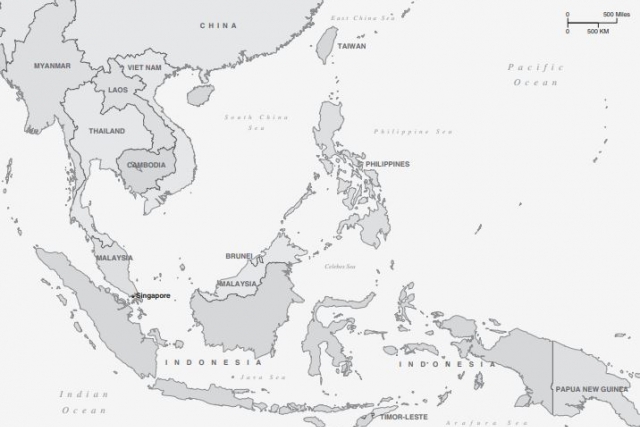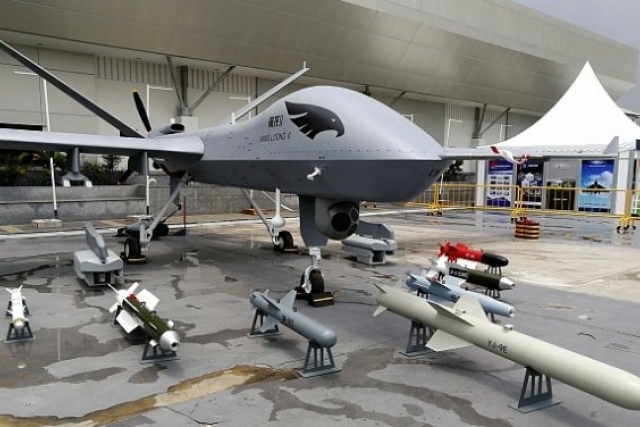Mixing Business with Pressure: Chinese Arms Sales in South East Asia

South East Asia (image: SIPRI)
China is pulling off the impossible- selling arms to nations it is in conflict with over its claim in the South China Sea (SCS). Maintaining a balance between business and conflict, China has kept up pressure by building and militarizing artificial islands in the SCS; at the same time it courts countries such as Malaysia, Philippines and Indonesia – which have overlapping claims over the SCS- with attractively priced arms.
China’s arms sales policy in South East Asia (SEA) is derived from its policy of creating a large eco-system of arms buyers from countries that fall within its sphere of ‘Belt and Road Initiative,’ a grouping of nations from Asia to the Middle East and Africa where it is helping to create infrastructure and build trade.
At the same time, Beijing aggressively guards its “nine-dash line,” China’s claim over the SCS (as presented to the United Nations in 2009) that covers most of the South China Sea, extending down to the coast of Malaysia.
Zhou Bo, a senior colonel of the People’s Liberation Army (PLA) was quoted as saying by CNBC during the 2019 Shangrila Dialogue- a regional security pow-wow in Singapore, “China does need to have necessary defense of these islands and rocks (In the SCS) which we believe are Chinese territory.”
While Beijing claims almost the entire South China Sea, it controls only seven reefs in the Spratlys, which were all transformed into islands through massive land reclamation starting from 2014. The Spratlys are also claimed by Vietnam, the Philippines, Malaysia, Brunei and Taiwan.
Some 13% of Chinese exports of major arms went to the SEA region in 1999–2018. China’s arms exports to SEA have benefited from competitive pricing, technology transfer and joint- production and maintenance. In addition, it does not lay any end-user condition like what the United States does.
Of late, with increased patrolling of the SCS by US Navy ships citing freedom of navigation, SE Asian nations have not been confronting the Chinese navy or coast guard. China too has been less belligerent not wanting to flex its muscles at the US Navy.
Arms trade and SCS disputes with major SEA countries are detailed below:

INDONESIA
China sent coast guard vessels to escort numerous fishing boats near the Natuna waters containing significant oil and gas reserves in December 2019, claiming to have traditional fishing rights. The Natuna sea is within 200 nautical miles (370km) of Indonesia’s coastline, making it part of its Exclusive Economic Zone (EEZ), as per 1982's United Nations Convention on the Law of the Sea (UNCLOS).
In days following the recent Chinese intrusion, Indonesia dispatched warships and Su-30 jets and announced an intension to buy US F-16 jets and warships from Europe.
The tensions then cooled down after both sides withdrew their ships and since then the Chinese Coast Guard has not made any aggressive intrusions in the Natuna waters.
Indonesia buys its arms from a diverse group of countries including China that accounted for 4.8% of arms sales between 1999 & 2018.
Between 2015 and 2018 Indonesia's arms imports totaled around $2.5 billion. China’s arms exports to Indonesia stood at 4.8% of its total arms imports between 1999-2018, according to data from Stockholm International Peace Research Institute (SIPRI).
Indonesia, had ordered C-802 anti-ship missiles, portable surface-to-air missiles and air defense radars from China from 2005 through 2009. Since then, arms buys from China have cooled off. But recent indications- the presence of Chinese arms companies at Indonesia’s defense trade fair- shows Beijing might still be trying to woo Jakarta for arms sales.
China is reported to have bought four strike-capable Wing Loong I medium-altitude, long-endurance UAVs from Chinese state-owned aerospace and defense company Aviation Industry Corporation of China back in 2017, Jane’s reported quoting Indonesian sources. This information has not been officially confirmed.
VIETNAM
China-Vietnam relations soured over the former's militarization of Fiery Cross Reef. China installed some military structures on more reefs in the vicinity of the Philippines and Vietnamese occupied islands and this led to escalating tensions between these countries.
A 2019 Vietnam Defence White Paper document stresses more defense cooperation among 10 Southeast Asian nations and calls settling differences with China a “long-term, difficult and complex process involving multiple countries and parties.” The two Asian neighbors, which have centuries of border disputes, now contest sovereignty over tracts of the South China Sea.
Recent diplomatic parleys between Hanoi and Beijing indicate a desire for normalization while not giving much leverage to one another in the SCS. Beijing’s immediate worry seems to be to contain growing US arms sales to Hanoi.

PHILIPPINES
Both China and Philippines claim Spratly Islands and Scarborough Shoal located in the South China Sea. Scarborough Shoal was formerly administered by the Philippines. In a 2012 Scarborough Shoal standoff, China sent warships to invade and overtake the administration of the shoal.
According to experts, control over Scarborough would create a large “strategic triangle” comprising Woody Island in the Paracel Islands to the northwest and its Spratly islet outposts to the south, giving Beijing the ability to police an air defense identification zone (ADIZ) in the South China Sea.
After the 2012 standoff with China, Philippines’ military spending has gradually increased. In 2012, it spent $2.7 billion and the next year it shot up to $3.09 billion. Between 2011-14, Manila spent $11.2 billion. From 2015-2018, it increased to $14.9 billion, according to SIPRI.
“The violent anti-drugs operations (commencement- July 2016) of President Rodrigo Duterte of the Philippines have led to severe criticism from Western states and in some cases a refusal to export weapons that can be used for internal operations. When Western states criticized the Philippines and withheld export permissions for some equipment, Russia and China quickly offered to make up the shortfall, on competitive terms, whatever the Philippines was unable to obtain due to the restrictions. Such generosity was partly for commercial reasons, but also had a political motive, especially in the case of China,” SIPRI report said.
Interestingly, in December 2016, Philippines announced its decision to accept arms from China with a 25-year repayment plan. "China is pressing me on the firearms, which are already there. I'll accept them. They're rushing it," said President Rodrigo Duterte.
Philippines-China ties improved when Philippine President Rodrigo Duterte opted to temporarily set aside Manila's territorial disputes on the South China Sea with Beijing in order to revive the two countries’ economic relations.
In the year that followed, Philippines submitted the list of defense equipment it hopes Beijing can supply through a $14-million grant. Defense Secretary Delfin Lorenzana is said to have disclosed another additional procurement demand for $500 million worth of weapons from China, including precision-guided munitions, boats and UAVs (unmanned aerial vehicle).
In June 2017, it received some 3,000 rifles with 5 million ammunition and 90 units sniper rifles with 800,000 ammunition from China for free. China handed over the second batch of military equipment to the Philippines that include 3,000 M4 rifles, three million rounds of assorted ammunition, and 30 sniper scopes.
“China is seen as an alternative to Western suppliers. At the same time, Philippines continues to accept military aid from the USA, such as the maritime surveillance system delivered in 2018 for use on a C-130 transport aircraft, and to buy weapons from the USA, such as the Paveway guided bombs ordered in mid-2018, even where alternatives from less critical countries exist,” SIPRI report said.
MALAYSIA
Malaysia occupies about five of the Spratly (islands) and lays claim to 12. Any claim on the South China Sea and its islands is challenged by China as per its unilaterally imposed nine-dash line. Despite the dispute, China and Malaysia seem to be warming up to each other.
China displayed its FD-2000 air defense missile system, F-22P frigate and LPD dock landing ship eyeing South East Asian defense market at LIMA 2015. In the later editions of the exhibition, Beijing showcased its Wing Loong II drone and unveiled an oddly shaped attack drone named Blowfish A2.
In March 2017, Malaysia bought four Chinese Keris-class littoral mission ships for RM1.17 billion (nearly $285 million). The agreement is the first time a Chinese contractor will build military equipment for Malaysia, Global Times reported. The SE Asian country is also in line to buy a Medium Altitude Long Endurance (MALE) drone. In a first direct competition between Chinese and US military products, the former’s Wing Loong II drone will be competing against the US-made MQ-9 Predator B in a potential tender for UAVs in Malaysia.
At LIMA-2019, Malaysia kicked off its light fighter jet procurement by issuing request for information (RFI) to five manufacturers: Russian Yak-130, Indian Tejas, Pakistani-Chinese JF-17, Italian Aermacchi MB-339 and South Korean T-50.

THAILAND
Thailand takes a neutral stance when it comes to the South China Sea conflict. “Following the military coup of May 2014, several European suppliers again re-evaluated their relations with Thailand. This and Thai unease about the impact of the coup on other arms deals probably helped China to win orders for tanks, armoured vehicles and submarines after 2015,” the SIPRI report said.
China won a 36 billion baht ($1 billion) order to supply 3 Yuan-class S26T submarines to Thailand in 2017. Beijing also agreed to provide CM-708 missiles, which can be fired from the submarines over a range of 290km, free of charge. Thailand has also acquired multiple rocket launchers (MRLs) with technology transfers to develop a Thai MRL.
“In 2017 Thailand ordered first of three planned S-26T submarines from China, its largest investment in any single type of major weapon since 2010. The acquisition process was criticized in Thailand. The need for submarines has not been explained and the final decisions on funding and the contract were not transparent,” the SIPRI document said.
The first of S26T submarines, derived from China’s Type 039A, is expected to be delivered to the Thai Navy in 2023.
In the same year, 28 Chinese VT4 battle tanks costing 4.9 billion baht ($150.5 million) were delivered to Thailand under a deal signed earlier that year. “Plans for additional armored vehicles from Ukraine were shelved in 2015 in favour of an order with China for 28 VT-4 tanks, to be followed by 10 more in 2017 as well as 34 VN-1 IFVs. Additional VT-4 and VN-1 purchases are planned,” the report said.
From 1999 to 2018, major suppliers of arms to Thailand are US (21.4%), Sweden (13.5%) and Ukraine (12.6%). Although China (11%) comes fourth, it still beats other western nations such as Germany (7.7%), Italy (7.5%), UK (3.4%) and France (3.3%).
|
Country |
Year |
Arms sales with China |
|
Indonesia |
2005-09
2017
|
C-802 anti-ship missiles, portable surface-to-air missiles and air defense radars
Wing Loong I medium-altitude, long-endurance UAVs (unconfirmed) |
|
Philippines |
2017 (Chinese grant) |
3,000 rifles with 5 million ammunition and 90 units sniper rifles with 800,000 ammunition from China 3,000 M4 rifles, 3 million rounds of assorted ammunition, and 30 sniper scopes |
|
Malaysia |
2017 |
4 Chinese Keris-class littoral mission ships for RM1.17 billion (nearly $285 million)
Wing Loong II drone (potential sale) |
|
Thailand |
2017 |
28 Chinese VT4 battle tanks costing 4.9 billion baht ($150.5 million)
3 Yuan-class S26T submarines for 36 billion baht ($1 billion) order |









